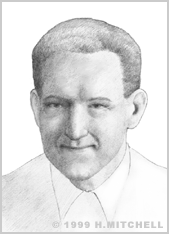Nathaniel Wyeth
Nathaniel Wyeth’s most famous invention, one of the most convenient and readily recyclable items available for sale today, is the plastic soda bottle.
Nat Wyeth was born near Chadds Ford, Pennsylvania, into America’s foremost family of artists: both of his sisters and most notably his brother, Andrew, followed in the footsteps of their father, artist and illustrator Newell Convers (N.C.) Wyeth. But by the age of 3, Nat - then named N.C. Wyeth, Jr. - showed such a fascination for working the wheels and brakes of his baby carriage that his father renamed his son after his brother Nathaniel, an engineer.
Indeed, young Nat went on to show the typical budding inventor’s interest in gadgets, disassembling clocks and using their parts to make model speedboats, cutting up tin cans and soldering the pieces to make universal joints, and so on. By the time he was ready for college, Nat followed another uncle’s advice and chose the University of Pennsylvania for its engineering program.
One of the successes of Wyeth’s college years was perfecting a 20-foot long hydroplane boat that could reach speeds of 50 m.p.h., resting on two pontoons and powered by a Ford V-8 engine. After graduating from Penn, Wyeth joined his namesake uncle at General Motors, in their Delco division. But soon thereafter, Wyeth jumped at the chance to work for Du Pont Corporation in Wilmington, Delaware, not far from his hometown.
Wyeth made a good impression early on, by inventing a plug-proof valve for a production machine. He was transferred to the mechanical development lab, where one of his first inventions was an elaborate machine that manufactured dynamite cartridges automatically: this meant that workers were no longer exposed to poisonous nitroglycerin powder. Another invention was a machine with magnetized rollers, used to manufacture Typar®, a nonwoven polypropylene fabric used in textiles and construction.
Wyeth began work on his best known invention in 1967. After wondering out loud at work why plastic was not used for carbonated beverage bottles, Wyeth was told that they would explode. He promptly went to a store, bought a plastic bottle of detergent, returned home, replaced the detergent with ginger ale, sealed the bottle, and put it in the refrigerator. The next morning, the bottle had swollen up so much that it was wedged solidly between the refrigerator shelves. Wyeth intuited that there was a way to make a stronger plastic container; and after a great deal of experimentation, he found it.
Wyeth knew that stretching out nylon thread strengthened it by forcing its molecules to align. The challenge he faced was stretching plastic so that its molecules would align in two dimensions, rather than just one. He managed this by creating a “preform” mold for the bottle, which resembled a test tube with screw threads running, not in a single spiral, but in a diamond criss-cross pattern. When the plastic was pressed, or “extruded,” through this mold, the molecules aligned in the “biaxial” fashion Wyeth intended. His final improvement was to replace the polypropylene material he had been using with polyethylene-terephthalate (“PET”), which has superior elastic properties. The final product was light, clear, resilient, and safe: a complete success.
PET is also eminently recyclable. Though recycling was not a major concern to Wyeth at the time he patented his process in 1973, PET soda bottles were first recycled in 1977, and are now perhaps the most commonly recycled household products. Recycled PET (“#1” plastic) is used mainly as “fiberfill” or as synthetic fabric: for example, about half of the polyester carpet made in the U.S. today comes from recycled PET bottles.
Nathaniel Wyeth, whose many patents cover a broad range of mechanical processes, never enjoyed professional fame during his career as the artists in his family did; but he has become, if inadvertently, a hero of the recycling movement.
Wyeth passed away on July 4, 1990 at 78 years old.


